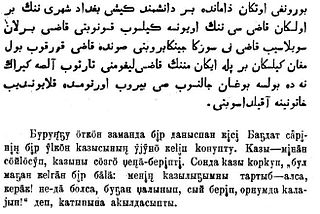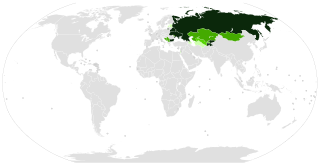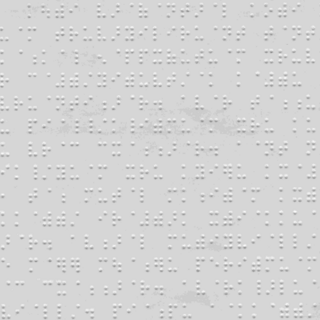
Kazakh or Qazaq is a Turkic language of the Kipchak branch spoken in Central Asia by Kazakhs. It is closely related to Nogai, Kyrgyz and Karakalpak. It is the official language of Kazakhstan and a significant minority language in the Ili Kazakh Autonomous Prefecture in Xinjiang, north-western China, and in the Bayan-Ölgii Province of western Mongolia. The language is also spoken by many ethnic Kazakhs throughout the former Soviet Union, Germany, and Turkey.
Three scripts are currently used for the Tatar language: Arabic, Cyrillic and Latin.

Faux Cyrillic, pseudo-Cyrillic, pseudo-Russian or faux Russian typography is the use of Cyrillic letters in Latin text, usually to evoke the Soviet Union or Russia, though it may be used in other contexts as well. It is a common Western trope used in book covers, film titles, comic book lettering, artwork for computer games, or product packaging which are set in or wish to evoke Eastern Europe, the Soviet Union, or Russia. A typeface designed to emulate Cyrillic is classed as a mimicry typeface.

The dotted i, also called decimal i or soft-dotted i, is a letter of the Cyrillic script. It commonly represents the close front unrounded vowel, like the pronunciation of ⟨i⟩ in English "machine". It is used in the orthographies of Belarusian, Kazakh, Khakas, Komi, Carpathian Rusyn and Ukrainian and quite often, but not always, is the equivalent of the Cyrillic letter i (И и) as used in Russian and other languages. However, the letter І was also used in Russian before the Bolshevik reform of 1918.

The Kyrgyz alphabets are the alphabets used to write the Kyrgyz language. Kyrgyz uses the following alphabets:

Three alphabets are used to write Kazakh: the Cyrillic, Latin and Arabic scripts. The Cyrillic script is used in Kazakhstan, Russia, and Mongolia. An October 2017 Presidential Decree in Kazakhstan ordered that the transition from Cyrillic to a Latin script be completed by 2031. The Arabic script is used in Saudi Arabia, Iran, Afghanistan, and parts of China.

Numerous Cyrillic alphabets are based on the Cyrillic script. The early Cyrillic alphabet was developed in the 9th century AD and replaced the earlier Glagolitic script developed by the theologians Cyril and Methodius. It is the basis of alphabets used in various languages, past and present, Slavic origin, and non-Slavic languages influenced by Russian. As of 2011, around 252 million people in Eurasia use it as the official alphabet for their national languages. About half of them are in Russia. Cyrillic is one of the most-used writing systems in the world. The creator is Saint Clement of Ohrid from the Preslav literary school in the First Bulgarian Empire.
JCUKEN is the main Cyrillic keyboard layout for the Russian language in computers and typewriters. Earlier in Russia JIUKEN (ЙІУКЕН) layout was the main layout, but it was replaced by JCUKEN when the Russian alphabet reform of 1917 removed the letters Ѣ, І, Ѵ, and Ѳ. The letter Ъ had decreased in usage significantly after the reform.

Russian Braille is the braille alphabet of the Russian language. With suitable extensions, it is used for languages of neighboring countries that are written in Cyrillic in print, such as Ukrainian and Mongolian. It is based on the Latin transliteration of Cyrillic, with additional letters assigned idiosyncratically. In Russian, it is known as the Braille Script.

Bharati braille, or Bharatiya Braille, is a largely unified braille script for writing the languages of India. When India gained independence, eleven braille scripts were in use, in different parts of the country and for different languages. By 1951, a single national standard had been settled on, Bharati braille, which has since been adopted by Sri Lanka, Nepal, and Bangladesh. There are slight differences in the orthographies for Nepali in India and Nepal, and for Tamil in India and Sri Lanka. There are significant differences in Bengali Braille between India and Bangladesh, with several letters differing. Pakistan has not adopted Bharati braille, so the Urdu Braille of Pakistan is an entirely different alphabet than the Urdu Braille of India, with their commonalities largely due to their common inheritance from English or International Braille. Sinhala Braille largely conforms to other Bharati, but differs significantly toward the end of the alphabet, and is covered in its own article.

French Braille is the original braille alphabet, and the basis of all others. The alphabetic order of French has become the basis of the international braille convention, used by most braille alphabets around the world. However, only the 25 basic letters of the French alphabet plus w have become internationalized; the additional letters are largely restricted to French Braille and the alphabets of some neighboring European countries.
Ukrainian Braille is the braille alphabet of the Ukrainian language. It is based on Russian Braille, with a few additional letters found in the print Ukrainian alphabet.
Several braille alphabets are used in Ghana. For English, Unified English Braille has been adopted. Four other languages have been written in braille: Akan (Twi), Ga, Ewe, and Dagaare. All three alphabets are based on the basic braille letter values of basic Latin alphabet:
Mongolian Braille is the braille alphabet used for the Mongolian language in Mongolia. It is based on Russian Braille, with two additional letters for print letters found in the Mongolian Cyrillic alphabet.
The braille alphabet used for the Kyrgyz language is based on Russian Braille, with a few additional letters found in the print Kyrgyz alphabet.
Khmer Braille is the braille alphabet of the Khmer language of Cambodia.
Belarusian Braille is the braille alphabet of the Belarusian language. It is based on Russian Braille, with a couple additional letters found in the print Belarusian alphabet.
The braille alphabet used for the Tatar language is based on Russian Braille, with several additional letters found in the print Tatar alphabet.
The Komi language, a Uralic language spoken in the north-eastern part of European Russia, has been written in several different alphabets. Currently, Komi writing uses letters from the Cyrillic script. There have been five distinct stages in the history of Komi writing:
Even alphabets are the alphabets used to write the Even language. During its existence, it functioned on different graphic bases and was repeatedly reformed. At present, Even writing functions in Cyrillic. There are three stages in the history of Even writing:








